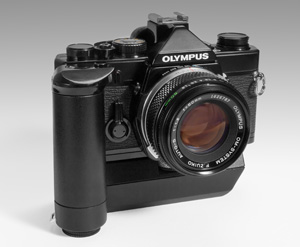Designed by Yoshihisa Maitani, the Olympus OM-1
was produced to challenge the Nikon F range of cameras by producing a smaller,
lighter and quieter 35mm SLR. It was first launched in 1972 as the M-1,
but after a complaint from Leica it was renamed the OM-1: the OM-1n is a later
version that has extra flash functions. This is an all mechanical manual
camera with the batteries only required to power the TTL exposure metering, this
being indicated by a
needle in the viewfinder. There is no other information in the viewfinder
i.e. the selected shutter speed and aperture, unlike the
Pentax MX and Nikon FM which have indicators for these settings.
The name Zuiko,
pronounced Z(u)weeko, is an abbreviation for the Olympus optical plant
written in Chinese and can be translated as "Golden Light".
A superb camera
complemented by the
range of excellent Olympus Zuiko lenses.
Winders & Motor Drives
The OM-1n above is shown fitted whit the Olympus
Winder 2. This gives a continuous shooting rate of 2.5 frames per
second (fps). The earlier Winder 1 just allowed for a single frame
advance. The MD-1 and MD-2 motor drive units would give 5 fps.
The MD-2 gave more shooting options which are shown in a LCD display.
Power came from a rechargeable NiCad battery pack or from 12 X AA
batteries housed in a vertical grip.
Camera Evolution
Soon after the OM-1 was introduced in 1972, it was
updated in 1973 to give it the capability to accept a winder or motor
drive. A small “MD” badge was fitted on the front of these models.
It was further updated in 1979 into the OM-1n which came with a
detachable hot shoe already fitted, earlier OM-1 models came without a
hot shoe, which provided better communication with the Olympus "T" flash
system. The OM-1n was finally discontinued in 1987 which ended the
production of Olympus manual mechanical SLRs.

